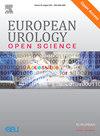瑞士活检前多参数磁共振成像对前列腺癌检测的影响
IF 3.2
3区 医学
Q1 UROLOGY & NEPHROLOGY
引用次数: 0
摘要
背景与目的多参数磁共振成像(mpMRI)引导下的前列腺活检已经成为标准的治疗方法。本研究旨在分析瑞士采用多参数磁共振成像(mpMRI)引导前列腺活检期间检测到的前列腺癌(PCa)危险人群分布的变化。方法本生态学研究分析了2005年1月至2019年12月期间瑞士一家三级医院的前列腺活检和瑞士国家癌症登记机构的前列腺癌诊断。一项调查评估了瑞士泌尿科中心的mpMRI吸收情况。计算和比较整个时期和每年的PCa风险组比例。主要发现和局限性分析了医院数据集中4890例活检和74747例国家前列腺癌病例。在mpMRI应用之前,72.6%的医院活检为PCa阴性,其中46.4%为低危(LR), 30.5%为中危(IR), 23.2%为高危(HR)。经mpMRI检查后,45.7%为PCa阴性,LR为24.6%,IR为49.0%,HR为26.5%。全国mpMRI使用率始于2008年,到2019年超过95%。2005年,在14个州记录了3448例PCa病例,其中46.3%为LR, 33.1%为IR, 20.6%为HR。截至2019年,23个州共登记6868例,其中LR占28.0%,IR占48.9%,HR占23.2%。结论及临床意义应用mpMRI后,前列腺活检阴性结果较少。此外,在风险群体的分布中发现了变化,随着mpMRI的采用,IR病例的比例增加,LR病例的比例下降。随着时间的推移,HR病例的比例基本保持不变。需要进一步的研究来确定这是否反映了分层的改善或诊断途径的改变。在这项研究中,我们研究了2005年至2019年在瑞士采用多参数磁共振成像(mpMRI)引导的前列腺活检期间检测到的前列腺癌等级的变化。在mpMRI之后,阴性活检的发生减少了,前列腺癌分级的分布发生了变化,发现了更多的中危和更少的低危癌症,而高风险病例保持稳定。本文章由计算机程序翻译,如有差异,请以英文原文为准。
Impact of Prebiopsy Multiparametric Magnetic Resonance Imaging on Prostate Cancer Detection in Switzerland
Background and objective
Multiparametric magnetic resonance imaging (mpMRI)-guided prostate biopsies have become the standard of care. This study aims to analyze changes in the distribution of detected prostate cancer (PCa) risk groups in Switzerland during the adoption period of a multiparametric magnetic resonance imaging (mpMRI)-guided prostate biopsy.
Methods
This ecological study analyzed prostate biopsies from a tertiary hospital and PCa diagnoses from the National Agency for Cancer Registration in Switzerland between January 2005 and December 2019. A survey assessed mpMRI uptake in Swiss urological centers. PCa risk group proportions were calculated and compared for the entire period and annually.
Key findings and limitations
A total of 4890 biopsies in the hospital dataset and 74 747 national PCa cases were analyzed. Before mpMRI availability, 72.6% of hospital biopsies were PCa negative, with detected cases including 46.4% low risk (LR), 30.5% intermediate risk (IR), and 23.2% high risk (HR). After the availability of mpMRI, 45.7% were PCa negative, with 24.6% LR, 49.0% IR, and 26.5% HR. National mpMRI uptake began in 2008, surpassing 95% by 2019. In 2005, 3448 PCa cases were recorded across 14 cantons, with 46.3% LR, 33.1% IR, and 20.6% HR. By 2019, 6868 cases were registered in 23 cantons, with 28.0% LR, 48.9% IR, and 23.2% HR.
Conclusions and clinical implications
After implementation of mpMRI, fewer negative prostate biopsy results were observed. Furthermore, a shift was detected in the distribution of risk groups, with an increase in the proportion of IR cases and a decline in LR cases alongside the uptake of mpMRI. The proportion of HR cases remained essentially constant over time. Further research is needed to determine whether this reflects improved stratification or an artifact of the changed diagnostic pathway.
Patient summary
In this study, we examined how the detected prostate cancer grades changed during the adoption of multiparametric magnetic resonance imaging (mpMRI)-guided prostate biopsies in Switzerland between 2005 and 2019. After mpMRI, fewer negative biopsies occurred and the distribution of prostate cancer grades changed, with more intermediate-risk and fewer low-risk cancers identified, while high-risk cases remained stable.
求助全文
通过发布文献求助,成功后即可免费获取论文全文。
去求助
来源期刊

European Urology Open Science
UROLOGY & NEPHROLOGY-
CiteScore
3.40
自引率
4.00%
发文量
1183
审稿时长
49 days
 求助内容:
求助内容: 应助结果提醒方式:
应助结果提醒方式:


